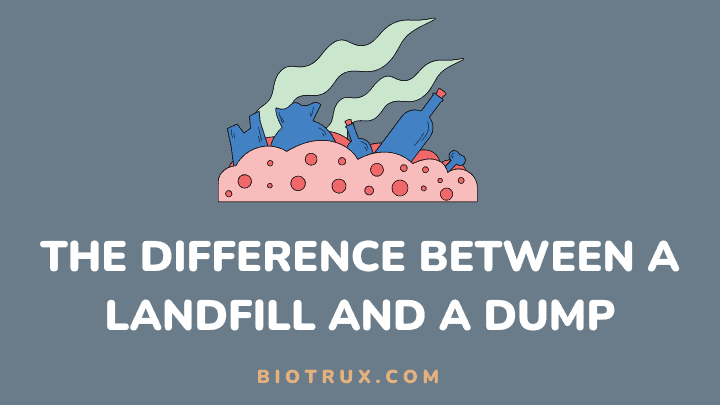Have you ever wondered about the difference between a landfill and a dump? Maybe you’ve heard that landfills are better for the environment than dumps but don’t know why. Or maybe you’re looking to dispose of some waste but can’t decide which option to choose.
Landfills and dumps both have specific purposes and implications when it comes to waste disposal and the environment. But they differ in handling this waste and its impact on our planet.
In this article, I’ll break down the differences between landfills and dumps and cover why each has its place in proper waste management. So, read on to learn more about a landfill and a dump.
The Problem of Waste Disposal
Waste disposal is a major challenge becoming increasingly concerning for society as population and consumption levels continue to rise. Inadequate waste management leads to substantial environmental, health, and financial consequences.
Thus, effective solutions must be identified and implemented. Pollution and contamination of air, water, and soil, along with the spread of disease, can all result from improper waste disposal. This can have damaging consequences for both human and animal life.
Furthermore, municipalities may face financial strain as landfills and dumps often require significant resources to construct and maintain. Therefore, waste management strategies must be implemented to minimize waste generation.
These strategies must encourage recycling and composting and ensure proper hazardous materials disposal. Landfills and dumps are two common waste disposal methods, but the two have important differences.
Overview of A Landfill

A landfill is a large, enclosed site to store and dispose of waste material. This waste usually consists of garbage collected from households and businesses across a specific area.
Materials such as paper, glass, plastic, metal, and yard waste can all be disposed of in landfills. Landfills come in many forms, some adapted from natural features like hollows and valleys.
The primary mechanism for disposing of the waste is covering it with soil so that it does not come into contact with the environment. Landfills must be managed correctly to ensure the waste does not contaminate nearby groundwater or release hazardous substances into the air.
Types of landfills
Landfills are the most common type of waste disposal and can be divided into three main categories: municipal solid waste landfills, industrial landfills, and hazardous waste landfills.
- Municipal solid waste (MSW) landfills dispose of garbage from households and businesses. As their name suggests, these landfills mainly contain non-hazardous materials such as food waste, paper, plastic, and cloth.
- Industrial landfills dispose of by-products from industrial processes and large items such as concrete, machinery, asphalt, and gypsum. These landfills must comply with stringent regulations to ensure that pollutants do not escape the surrounding environment.
- Finally, hazardous waste landfills dispose of dangerous materials, such as chemical wastes, medical wastes, and industrial solvents. Only approved hazardous materials may be disposed of in these landfills to prevent groundwater and soil contamination.
Advantages and disadvantages of a landfill
Advantages
- Landfills are an efficient way to manage our waste and reduce the amount of trash in our rivers, lakes, and oceans.
- Landfills are also a source of renewable energy through the capture and utilization of landfill gas which can be harnessed for productive purposes.
- Landfills provide employment opportunities and generate tax revenue for local communities.
Disadvantages
- Landfills are more expensive to establish and operate than dumps.
- Landfill sites often produce hazardous pollutants that can contaminate surrounding soils, water, and air.
- Landfills take up much land and resources to store and manage waste.
- Landfills can create odors impacting the local community’s quality of life and mental health.
Overview of A Dump

A dump site is an area where waste materials are disposed of in an unregulated manner. Dump sites can include solid and liquid materials, such as hazardous chemical waste, general garbage, industrial runoff, sewage, food scraps, etc.
They may be constructed on vacant lots or landfills or simply as open pits or temporary landfills. Dump sites pose serious environmental risks, including air and water pollution from leachate, soil contamination, and interference with animal habitats.
Moreover, they often lack adequate covering or containment to prevent toxic substances from leaching into nearby waterways or land. Dump sites must be managed responsibly to protect ecosystems and public health.
Types of dumps
There are three main types of dump sites: open dumps, sanitary dumps, and controlled/regulated dumps.
- Open dumps are the most common type of dumping site and involve depositing waste in an area without environmental controls. While these sites may be cheaper in the short term, they can cause environmental damage due to the leaching of hazardous materials, air and water pollution, and the potential spread of disease.
- Sanitary dumps have been improved with some environmental control measures but do not meet modern standards.
- Finally, controlled/regulated landfills are designed with even stricter environmental standards. These include restrictions on the types of waste that can be deposited, rigorous testing and monitoring requirements, and other measures to protect nearby communities.
Advantages and disadvantages of a dump
Advantages
- Dumps are a cheaper waste disposal method than landfills or other waste management strategies.
- Dumps can be easily accessed, especially in rural areas, where the nearest landfill may be too far away.
- Dumps can accept a wide range of waste types, including hazardous waste, which may not be allowed in some landfills.
Disadvantages
- Dumps can cause significant environmental damage, including soil and water pollution and harm to wildlife.
- Dumps can pose significant health risks to nearby communities due to releasing harmful chemicals and hazardous waste.
- Dumps are often unregulated, leading to illegal dumping and a lack of proper waste management practices, making them difficult to monitor and manage effectively.
Differences Between a Landfill and a Dump
1. The location: A landfill is typically managed sites away from populated areas, while a dump is often unsanctioned and located in or near inhabited areas.
2. Regulation: A landfill must adhere to stringent regulations set by the Environmental Protection Agency (EPA), whereas a dump is generally not subject to such restrictions.
3. Waste Type: Landfills accept only certain types of solid waste, including yard trimmings and construction debris, whereas dumps can house various types of waste, including hazardous materials.
4. Operations: Landfills must be structured internally with layers of protective cover material, have air emissions and leachate control systems, and be monitored for long-term maintenance, whereas dumps often have none of these safeguards.
5. Aftercare: Once a landfill is closed, it will be covered and monitored for environmental safety; however, dumps may never receive any aftercare.
Which is Better?
Ultimately, a landfill is considered the safest and most efficient option for disposing of large waste. Compared to dumps, landfills offer superior protection from pollutants entering the environment and better control over the long-term effects of waste storage.
They also provide a way of sorting and segregating different types of waste. This can reduce the overall volume of material that needs to be processed. However, landfills remain an expensive solution due to the need for substantial infrastructure investment and ongoing operational costs.
Careful consideration must also be given to their location to minimize risks to human health and other environmental impacts. In many cases, recycling and composting may be more suitable options for managing certain types of waste.
Therefore, it is important to consider all available alternatives before deciding on the best waste disposal option.
Factors to Consider in Choosing Between A Landfill and A Dump
Several factors should be considered when selecting a waste disposal site between a dump and a landfill.
Firstly, the type of waste and its volume must be established; landfills are more suitable for certain types of waste than dumps. Furthermore, environmental impacts must be considered, as landfills are designed to mitigate environmental damage.
Lastly, economic costs should be weighed, as a dump may be the most cost-effective option in some cases. To ensure a sound decision is made, consulting with experts on waste management and local regulatory agencies is essential.
Ultimately, a sustainable solution that adheres to health, environmental and economic standards should be prioritized.
FAQs
What are the alternatives to landfills and dumps?
Alternative waste management strategies include recycling, composting, waste-to-energy facilities, and zero-waste initiatives. Recycling and composting reduce waste generation, and waste-to-energy facilities convert waste into energy. Zero waste initiatives aim to eliminate waste by promoting sustainable consumption and production patterns.
What are the environmental impacts of landfills and dumps?
Both landfills and dumps can have negative environmental impacts such as soil and water pollution, releasing harmful gases, and harming wildlife. These impacts can be minimized through proper waste management practices such as recycling, composting, and waste reduction.
How can we ensure proper waste management practices?
Proper waste management practices can be ensured through community education and awareness, government regulations and policies, and systems promoting sustainability and environmental protection.
Final Thoughts
We may often use the words “landfill” and “dump” interchangeably, but they have important differences. Landfills are carefully regulated and managed, where trash is separated and buried in layers to preserve our environment.
In contrast, dumps lack any regulation, are uncontrolled, and can increase air, land, and water pollution if not managed properly. These two terms represent very different approaches to waste management, and we must understand the implications of each.
Despite the obvious differences between these waste disposal methods, both have distinct advantages when managing our ever-growing material surplus volume. To truly make a difference in our environment, we must recognize each method’s unique role in our collective effort to tackle waste.
We must also make wise decisions about using and managing our planet’s resources.
Learn more about recycling paper with staples.
Thanks for reading.

